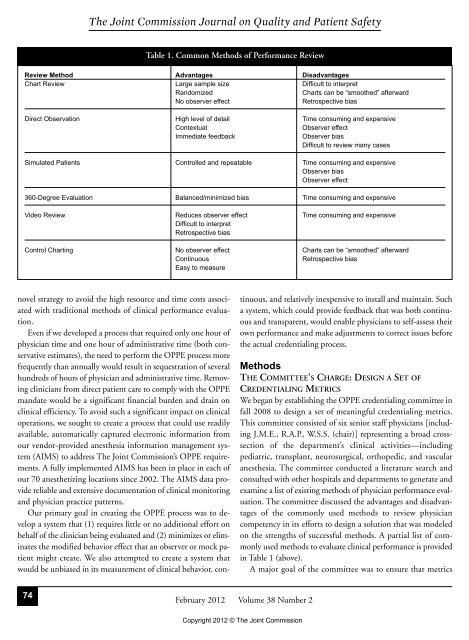(OPPE) Using Automatically Captured Electronic Anesthesia Data
(OPPE) Using Automatically Captured Electronic Anesthesia Data
(OPPE) Using Automatically Captured Electronic Anesthesia Data
You also want an ePaper? Increase the reach of your titles
YUMPU automatically turns print PDFs into web optimized ePapers that Google loves.
74<br />
The Joint Commission Journal on Quality and Patient Safety<br />
novel strategy to avoid the high resource and time costs associated<br />
with traditional methods of clinical performance evaluation.<br />
Even if we developed a process that required only one hour of<br />
physician time and one hour of administrative time (both conservative<br />
estimates), the need to perform the <strong>OPPE</strong> process more<br />
frequently than annually would result in sequestration of several<br />
hundreds of hours of physician and administrative time. Removing<br />
clinicians from direct patient care to comply with the <strong>OPPE</strong><br />
mandate would be a significant financial burden and drain on<br />
clinical efficiency. To avoid such a significant impact on clinical<br />
operations, we sought to create a process that could use readily<br />
available, automatically captured electronic information from<br />
our vendor-provided anesthesia information management system<br />
(AIMS) to address The Joint Commission’s <strong>OPPE</strong> requirements.<br />
A fully implemented AIMS has been in place in each of<br />
our 70 anesthetizing locations since 2002. The AIMS data provide<br />
reliable and extensive documentation of clinical monitoring<br />
and physician practice patterns.<br />
Our primary goal in creating the <strong>OPPE</strong> process was to develop<br />
a system that (1) requires little or no additional effort on<br />
behalf of the clinician being evaluated and (2) minimizes or eliminates<br />
the modified behavior effect that an observer or mock patient<br />
might create. We also attempted to create a system that<br />
would be unbiased in its measurement of clinical behavior, con-<br />
Table 1. Common Methods of Performance Review<br />
Review Method Advantages Disadvantages<br />
Chart Review Large sample size Difficult to interpret<br />
Randomized Charts can be “smoothed” afterward<br />
No observer effect Retrospective bias<br />
Direct Observation High level of detail Time consuming and expensive<br />
Contextual Observer effect<br />
Immediate feedback Observer bias<br />
Difficult to review many cases<br />
Simulated Patients Controlled and repeatable Time consuming and expensive<br />
Observer bias<br />
Observer effect<br />
360-Degree Evaluation Balanced/minimized bias Time consuming and expensive<br />
Video Review Reduces observer effect Time consuming and expensive<br />
Difficult to interpret<br />
Retrospective bias<br />
Control Charting No observer effect Charts can be “smoothed” afterward<br />
Continuous Retrospective bias<br />
Easy to measure<br />
tinuous, and relatively inexpensive to install and maintain. Such<br />
a system, which could provide feedback that was both continuous<br />
and transparent, would enable physicians to self-assess their<br />
own performance and make adjustments to correct issues before<br />
the actual credentialing process.<br />
Methods<br />
THE COMMITTEE’S CHARGE: DESIGN A SET OF<br />
CREDENTIALING METRICS<br />
We began by establishing the <strong>OPPE</strong> credentialing committee in<br />
fall 2008 to design a set of meaningful credentialing metrics.<br />
This committee consisted of six senior staff physicians [including<br />
J.M.E., R.A.P., W.S.S. (chair)] representing a broad crosssection<br />
of the department’s clinical activities—including<br />
pediatric, transplant, neurosurgical, orthopedic, and vascular<br />
anesthesia. The committee conducted a literature search and<br />
consulted with other hospitals and departments to generate and<br />
examine a list of existing methods of physician performance evaluation.<br />
The committee discussed the advantages and disadvantages<br />
of the commonly used methods to review physician<br />
competency in its efforts to design a solution that was modeled<br />
on the strengths of successful methods. A partial list of commonly<br />
used methods to evaluate clinical performance is provided<br />
in Table 1 (above).<br />
A major goal of the committee was to ensure that metrics<br />
February 2012 Volume 38 Number 2<br />
Copyright 2012 © The Joint Commission


